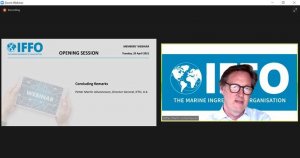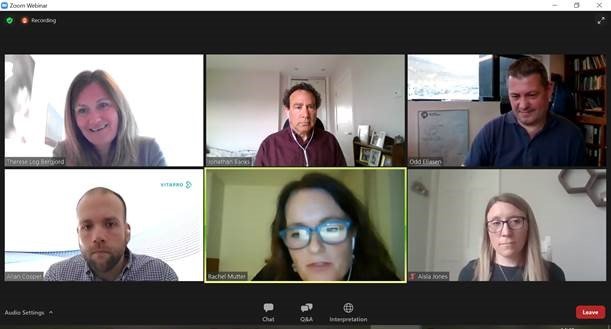Day 1 of the IFFO April Webinar looked at the industry’s adaptation to Covid 19 with a focus on shrimp and salmon. Presenters and panellists agreed that science and communication are key to developing knowledge and building collaboration throughout the value chain.
Open to scrutiny
 Anne Mette Baek, IFFO’s President, recognised that, marine ingredients being a key component of feeds, it is only natural that the sector come under scrutiny and provide information on the way the industry operates. With aquaculture being the fastest growing global production of animal protein today, interest is growing in what the future of seafood will look like. Anne Mette stated that responsible fishing exists, based on fishery management principles. Certification standards are here to flag the ecological, social and economic successes that certified small pelagic fisheries and fishmeal plants have realised so far. They also play an important role in setting the bar high for those not achieving the standards. Marine ingredients, mostly fishmeal and fish oil, have been key contributors to the birth and developments of aquaculture because of the combination of micronutrients (including minerals and vitamins), amino acids and omega3s (EPA and DHA) they offer in a single package.
Anne Mette Baek, IFFO’s President, recognised that, marine ingredients being a key component of feeds, it is only natural that the sector come under scrutiny and provide information on the way the industry operates. With aquaculture being the fastest growing global production of animal protein today, interest is growing in what the future of seafood will look like. Anne Mette stated that responsible fishing exists, based on fishery management principles. Certification standards are here to flag the ecological, social and economic successes that certified small pelagic fisheries and fishmeal plants have realised so far. They also play an important role in setting the bar high for those not achieving the standards. Marine ingredients, mostly fishmeal and fish oil, have been key contributors to the birth and developments of aquaculture because of the combination of micronutrients (including minerals and vitamins), amino acids and omega3s (EPA and DHA) they offer in a single package.
IFFO’s upcoming library on climate change
Baek underlined that climate change presents new challenges to fisheries governance and management. It is leading some of the world’s most heavily traded species to shift their distributions toward the north and south poles. As the scientific knowledge has improved on potential redistribution patterns, it is also providing strategic thinking to take relevant adaptation and mitigation measures. With COP26 in November this year, IFFO is building a library of actions taken by its members from across the industry to mitigate carbon emissions and adapt to climate change. These stories will be presented alongside the latest scientific insights on climate change and how it affects our industry and we hope they will help champion best practices.
Collaboration and engagement
In this changing landscape, Baek said that collaboration within the value chain, but also engagement with local authorities, should be the focus of IFFO’s attention. In the case of European fisheries, quota sharing for 2021 still has to be agreed upon by coastal states with regards to blue whiting, atlanto-scandian herring and mackerel. The fishing industry (ie the certificate holders) has already put a lot of efforts into this dispute, as have the marine ingredients industry and the feed producers. The bottom line is for governments to take their responsibility and ensure that discussions at an international level will resume. Only a transboundary cooperation and agreement will bring a solution.
The situation of these fish stocks can be a catalyst for collaboration between stakeholders from public and private sectors to be strengthened, not only in Europe, but also in other key regions where challenges lie and where fishery management principles are depending on a combination of regulations, law enforcement and scientific as well as technical knowledge.
Busy 2020 year for IFFO

2020 was a busy year for IFFO, where the organization focused on increasing value creation for its members despite covid 19’s consequences. As Petter Johannessen, IFFO’s Director General explained, a new market intelligence system was set up to increase the market coverage. Focusing on Asia, IFFO has also been developing its knowledge on Asian markets and working on the new Chinese fishmeal standard. To address existing challenges and develop best practices for the future, IFFO is continuously engaging with key stakeholders and the whole value chain, with science being core to this approach. Indeed, IFFO has been looking at Fish-In:Fish Out (FIFO) ratios and developing a more sophisticated approach. It has also been also applying science to anticipate the future state of our industry with regard to fish stocks and biomass and investigating the potential of new marine raw materials through joining initiatives on sustainable harvesting of meso pelagic species.
New events for IFFO Members
Aware as IFFO is that networking is a key expectation from its members, Johannessen explained that IFFO was working to be ready to have in-person events as soon as the COVID19 situation allows for it, but also looking into hybrid events, with virtual options available, even when we can hold events in person again. He announced that IFFO was developing new webinars for members: timely, accurate and tailored to member needs.
Securing responsibly-sourced materials
According to the FAO there is a need for 20 million tons of additional farmed seafood towards 2030. 25-30 million tons of additional feed ingredients are therefore required in this decade. “Collaboration is key for progress and will be of vital importance for securing enough healthy food for the ever-growing global population” said Johannessen.
IFFO will continue applying science to anticipate the future state of the industry about fish stocks and biomass. In addition to working for access to more responsible sourced raw materials, Johannessen explained that the industry also needs to challenge the supply chains again to secure access to more by-products from processing of wild caught and farmed seafood which we know represents a huge unused resource.
Panel discussion: Has Covid reshaped markets for salmon and shrimp?

Rachel Mutter, IntraFish Editor, moderated a fascinating discussion involving Therese Log Bergjord, from Skretting Group, Aisla Jones, from Co-op, Odd Eliasen, from Havsbrun, Jonathan Banks from Jonathan Banks Associates Ltd, and Allan Cooper, from Vitapro.
Shifts in consumer behaviour
Jonathan Banks started with a perspective from the UK, where dramatic changes have been seen since the pandemic’s arrival and are expected to stay in the future, such as online shopping, now up 16% from 6%. Fresh fish has done extremely well, business has adapted through technology and retail products are expected to remain high. Share prices show there is still confidence in food outlets and hospitality. Banks added that vegan diet trend is not expected to grow greatly in the UK, and the increase of middle-class people, willing to get the right levels of essential fatty acids, will ensure growth continues in aquaculture. From Aisla Jones’ perspective (Co-op), the real challenge during Covid has not been suppliers but logistics of getting products onto shelves: certain species have lost their access to market through Covid, combined with Brexit.
Reshaped markets for shrimp
The participants agreed that the shift has mainly been in the shrimp industry, which has adapted its supply chains to allow for a move to retail to be made. While 60% of Ecuador exports were to China before the pandemic, they have moved to the US and EU, with China only taking 40% of them, as explained by Allan Cooper from Vitapro. He noted that farmers are adapting at both farm and processing level, resulting in a shift to value added products. Shrimp farmers have now become more sustainably conscious, aware of compliance at a retail level.
Growing interest in sustainability
Green funds are increasingly knowledgeable of value chains and look carefully at feed ingredients. Climate change will be a hot topic, with carbon footprint becoming more important. Put into perspective, aquaculture and feed have a low footprint compared with other systems. Therese Log Bergjord expects new ingredients, most of which do not have the scale up, to be cost efficient and healthy but also to provide the assurance that the base raw materials are responsibly sourced. According to Allan Cooper from Vitapro, digital transformation, through analytics, will be the way forward to improve visibility and traceability, alongside innovation to diversify ingredients, using new proteins and improving feed efficiency.
Odd Eliasen from Havsbrun noted that in the Faroe Islands the salmon market has undergone a change, with sustainability remaining a hot topic and with a growing focus on retail. Aisla Jones noted an increase of interest on feed and provenance of fish species, while underlining that consumers expect retailers to provide supply chain assurances, such as MSC and MarinTrust certificates on responsible sourcing and production. She added that she would welcome other ingredients to be considered in terms of sustainability credentials, alongside marine ingredients.
Quality, origin and integration: what are the trends?
“The value chain needs to be more transparent and accessible”, stated Therese Log Bergjord, but “what you eat is more important than where it is produced”. There will be land-based salmon production, but the focus should be on larger supply chains.
Vertical integration, enabling producers to make their own feed, is not expected to increase in the short term in the shrimp sector, with Allan Cooper underlining that feed companies still have a strong role, through innovation to help improve technology, feed efficiency, as well as technology service and management models. “The market is not only product driven, it is service driven” he added. Odd Eliasen underlined a trend for salmon farmers to integrate feed production, which could be beneficial for large farmers in Norway and Chile, but not beyond: “We need a large field of companies and competition to have the best products”, he noted.
Communicating seafood stories more and better
The panel discussion ended with all panellists agreeing that more proactiveness is required in telling the industry’s good stories, educating the consumer on how to prepare and eat seafood and considering the big picture in terms of sustainability and transparency. All panellists called for marine ingredients producers to carry the emphasis on responsibility, making use of existing certification programmes and relying on fishery management principles, to help build these positive stories further.









